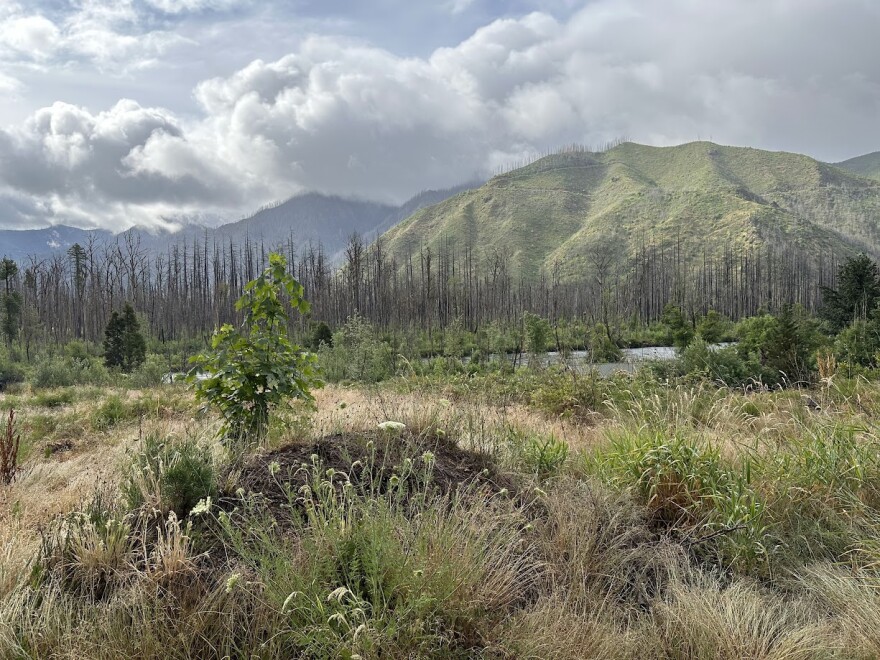This September marks five years since the Holiday Farm Fire burned up more than 173,000 acres in Oregon’s McKenzie River Corridor including Blue River. It’s a scenic mountain town that’s been around since 1900, with mining and timber as its former big industries.
The fire consumed hundreds of homes and businesses. In fact, most of the town was leveled.
Locals are still putting their community together, piece by piece.
The Holiday Farm Fire scorched a 27-mile path through this forested valley here, sending people fleeing in the middle of the night – most with only what they could throw in the car and wearing just the clothes on their backs.

The hills are still charred, as are the trees. Reconstruction is taking a while. Today, not even half the 500 homes that were destroyed have been rebuilt.
“It takes a village to rebuild a village, right?“ said Brandi Crawford Ferguson, showing off the latest development underway in downtown Blue River. She’s with the nonprofit McKenzie Community Land Trust.
Inching closer, Ferguson sidestepped a few extension cords and some ruts in the dirt road, while a nearby construction crew hammered and sawed away on six new houses.
“They’re 1,300 square feet, stick-built on site, three bedrooms, one and a half bath,” said Ferguson.
In the nearly five years since the fire, Ferguson said the cost to rebuild a home jumped 40%. But her organization is trying to make it a little more affordable for displaced families to come back.
“We will be selling the house but we won’t be selling the land,” she explained. “We will be holding onto the land, and families that buy the house will sign a 99-year lease.”
And since the value of the land isn’t included in the purchase price, these houses can be more affordable. They’ll sell for $250,000 to $275,000 - roughly half the typical price of a McKenzie River home.
A literal stone’s throw away is the Meyer’s General Store and Liquor Shop, or rather, the new one under construction. Owner Melanie Stanley said it will replace the original that was destroyed in the 2020 fire. Besides serving as a place to buy goods, the previous store was also a primary social and gathering hub for locals.
“Everybody kind of called it the unofficial town hall, which is how I ended up with the working title of unofficial mayor of Blue River,” laughed Stanley.
Stanley is hoping to open back up in September, but she might be the only shop on the block. Many of the lots around hers are still just patches of concrete. She's paying for the rebuild out of pocket, but others?
“The biggest problem and the biggest hurdle that most people are facing is cash flow and capital in order to be able to rebuild buildings and start those businesses back up, or start a business at all,” said Stanley.
The town’s population is now around 200 -- roughly a fourth what it was before the fire. And that’s hampering the town's ability to rebuild, generate business and boost tourism.
“The nice part is, is that at least a certain part of the year you have an influx of people with money coming to spend it in your community,” said Chris LaVoie, with McKenzie Community Partnership. He said Blue River does have lots of seasonal vacation homes and short-term rentals. The influx of cash supports the hospitality and recreation industry at a level that Blue River couldn’t on its population alone.

“But we also need to have jobs and regular stable income that comes throughout the year,” added LaVoie.
The town is talking about attracting more full-time remote workers. But in the meantime, it’s also banking on festivals and events to attract tourists. Like the McKenzie River Solstice Arts Festival.
A rainy day for a festival
“Let’s get a last round of applause for Doug (Heydon) and Amey (Herman), that was fantastic,” said emcee Indigo Greene from the main stage, as the musical group DnA packed up their instruments.
The event was getting doused pretty well by steady rain—a relative rarity for late June, even in rainy Oregon.
“The sun was shining a few minutes ago,” said event director Heather Greene. “And we have tiny baby frogs jumping all over, so it's a good omen.”
A good omen for generating some cash for the community.
“We have a collaborative local booth that is featuring local artists who were affected by the fires, or economically impacted by the recovery,” said Greene.
There were also food trucks and a raffle. Chainsaw artist Brittny Hughes showed off her skills with a tree stump that would become a “solstice pedestal.”
The only thing missing was a crowd.
“Alright, we got more arrivals!” said comedian Erica Figueroa, in a patio space away from the downpour. She tried to fire up a shivering audience of a half dozen people while also trying to talk over a food vendor’s generator.
“Thank you so much for coming to the party,” gushed Figueroa, as a few more people ran for cover and street tacos. “Lookit the tie dye, look at tie dye on black! We know it’s going to be a good time.”
The forecast for the solstice arts festival’s second day was warmer and drier, so the festival organizers hoped for better turnout.
Because in this small town, every visitor counts as it tries to make a comeback.
Copyright 2025, KLCC.




















